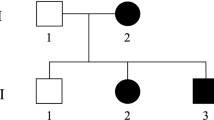Abstract
The mutant in a family with autosomal-dominant spastic paresis in Northern Tibet was mapped by linkage analysis with several microsatellite markers to a gene locus at 14q11.2–q24.3, an area to which a few mutants leading to a condition with similar clinical signs have previously been mapped. The mutant observed in this pedigree probably arose de novo. Gene loci at 2p21– p24 and 15q, which have been found for other pedigrees with dominant spastic paresis, were excluded. The data in this pedigree do not contradict the hypothesis proposed by another group that there might be anticipation.
Similar content being viewed by others
Author information
Authors and Affiliations
Consortia
Additional information
Received: 28 April 1997 / Accepted: 10 June 1997
Rights and permissions
About this article
Cite this article
Huang, S., Zhuyu., Li, H. et al. Another pedigree with pure autosomal dominant spastic paraplegia (AD-FSP) from Tibet mapping to 14q11.2–q24.3. Hum Genet 100, 620–623 (1997). https://doi.org/10.1007/s004390050563
Issue Date:
DOI: https://doi.org/10.1007/s004390050563




